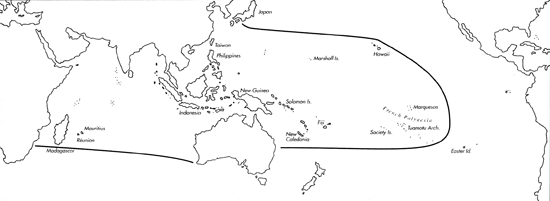Range: Natal to Red Sea and to Japan and Fiji; absent from Australia.
Description: Medium-sized to large, moderately solid to solid; relative weight may vary by 50 % in specimens of similar size. Last whorl conical, ventricosely conical or conoid-cylindrical; outline almost straight to convex. Shoulder angulate. Spire of low to moderate height, outline slightly concave to straight. Larval shell multispiral, maximum diameter 0.7-0.9 mm. Earliest postnuclear whorls weakly tuberculate. Teleoconch sutural ramps flat, often slightly concave in late whorls, with 1-2 increasing to 4-6 spiral grooves. Last whorl with weak, often granulose spiral ribs on basal third, widely spaced adapically.
| Shell Morphometry | ||
|---|---|---|
| L | 40-90 mm | |
| RW | 0.20-0.75 g/mm | |
| RD | 0.53-0.66 | |
| PMD | 0.82-0.91 | |
| RSH | 0.06-0.16 | |
Ground colour white. Last whorl with a continuous or interrupted, variably broad tan to dark brown spiral band on each side of centre. Ground-colour bands between usually crossed by darker brown axial flammules that often intersect colour bands. Occasionally, colour bands and flammules fuse, leaving only a narrow discontinuous median band. Closely spaced, dotted, dashed or solid brown spiral lines extend from base to shoulder, sometimes restricted to brown bands and rarely absent. Base yellowish to dark brown, contrasting with lighter adjacent area. Apex yellowish grey. Late sutural ramps tesselated with dark brown. Aperture white to cream.
Periostracum greyish brown, moderately thick, and rough.
Animal bright yellow; siphon with a dark brown halfring 1/3 the length from the tip (Kohn, unpubl. observ.).
Radular teeth with an adapical barb opposite a blade; serration terminates in a cusp at the central waist; base with a prominent spur (Peile, 1939; Nybakken, 1990). Bandel (1984) depicted a tooth with a long second barb instead of a blade and with a short serration without a terminal cusp.
Habitat and Habits: Intertidal to about 20 m; on sand, often with algae or mixed with coral rubble. In Mozambique, C. striatellus inhabits semi-sheltered sites insidereefs (Cernohorsky, 1964; Sharabati, 1984; Grosch, pers. comm., 1989; Tirard, pers. comm., 1989; Fainzilber et al., 1992). Egg diameter of 193 ┬Ám predicts a minimum pelagicperiod of about 24 days (Palau; Perron & Kohn, 1985).
Discussion: C. striatellus is similar to C. ferrugineus, C. planorbis, C. circumactus and C. swainsoni. C. ferrugineus differs in its fewer and more widely spaced spiral lines on the last whorl, cream to yellowish brown ground colour, and its thinner, translucent and tufted periostracum. C. planorbis is distinguished by the violet-brown colour of the anterior end of its aperture and the usually more widely spaced spiral lines on its last whorl. Neither of these two species has shells with a conoid-cylindrical last whorl. For comparisons with C. circumactus and C. swainsoni, see the Discussions of those species. C. lector. (Pl. 21, Figs. 30, 31) refers to a colour variant with reduced axially streaked pattern.

C. striatellus range map
This section contains verbatim reproductions of the accounts of 316 species of Conus from the Indo-Pacific region, from Manual of the Living Conidae, by R÷ckel, Korn and Kohn (1995). They are reproduced with the kind permission of the present publisher, Conchbooks.
All plates and figures referred to in the text are also in R÷ckel, Korn & Kohn, 1995. Manual of the Living Conidae Vol. 1: Indo-Pacific Region.
The range maps have been modified so that each species account has it own map, rather than one map that showed the ranges of several species in the original work. This was necessary because each species account is on a separate page on the website and not confined to the order of accounts in the book.